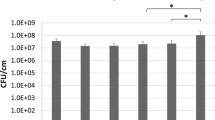Abstract
Fifty Foley bladder catheters that had been indwelling for periods ranging from 3 to 83 days (mean 35 days) were examined for the presence of bacterial biofilm. Scanning electron microscopy on freeze-dried cross-sections and fixed, critical point-dried longitudinal sections revealed biofilm formation on the luminal surfaces of 44 of the catheters. Culture of urine samples and sonicates from catheters revealed that the prevalence of bacteriuria was less than that of catheter colonization. A wide range of nosocomial species were found colonizing the catheters,Escherichia coli being most often isolated. The bacterial composition of the biofilms ranged from single species to mixed communities containing up to four species. There was no relationship between the length of time that the catheter had been in situ and the extent of biofilm formation. The biofilms varied in thickness from 3 to 490 µm and were visible as layers of bacterial cells up to about 400 cells deep, embedded in a matrix.
Similar content being viewed by others
References
Meers PD, Ayliffe GAJ, Emmerson AM, Leigh DA, Mayon-White RT, Mackintosh CA, Stronge JL National survey of infection in hospitals 1980. 2: Urinary tract infection. Journal of Hospital Infection 1981, Supplement 2: 23–28.
Christensen GD, Parisi JT, Bisno AL, Simpson WA, Beachey EH Characterization of clinically significant strains of coagulase-negative staphylococci. Journal of Clinical Microbiology 1983, 18: 258–259.
West TE, Walshe JJ, Krol CP, Amsterdam D Staphylococcal peritonitis in patients on continuous peritoneal dialysis. Journal of Clinical Microbiology 1986, 23: 809–812.
Franson TR, Sheth NK, Rose HD, Sohnle PG Scanning electron microscopy of bacteria adherent to intravascular chatheters. Journal of Clinical Microbiology 1984, 20: 500–505.
Dasgupta MK, Bettcher KB, Ulan RA, Burns V, Lam K, Dossetor JB, Costerton JW Relationship of adherent bacterial biofilms to peritonitis in chronic ambulatory peritoneal dialysis. Peritoneal Dialysis Bulletin 1987, 7: 168–173.
Ramsay JWA, Garnham AJ, Mulhall AB, Crow RA, Bryan JM, Eardley I, Vale JA, Whitfield HN Biofilms, bacteria and bladder catheters. British Journal of Urology 1989, 64: 395–398.
Nickel JC, Ruseska I, Wright JB, Costerton JW Tobramycin resistance ofPseudomonas aeruginosa cells growing as a biofilm on urinary catheter material. Antimicrobial Agents and Chemotherapy 1985, 27: 619–624.
Stickler DJ, Clayton CL, Chawla JC The resistance of urinary tract pathogens to chlorhexidine bladder washouts. Journal of Hospital Infection 1987, 10: 219–228.
Jensen ET, Kharazmi A, Lam K, Costerton JW, Hoiby N Human polymorphonuclear leukocyte response toPseudomonas aeruginosa grown in biofilms. Infection and Immunity 1990, 58: 2383–2385.
Costerton JW, Cheng KJ, Geesey GG, Ladd TI, Nickel JC, Dasgupta M, Marrie TJ Bacterial biofilms in nature and disease. Annual Reviews of Microbiology 1987, 41: 435–464.
Stickler D, Dolman J, Rolfe S, Chawla J Activity of antiseptics againstEscherichia coli growing as biofilms on silicone surfaces. European Journal of Clinical Microbiology & Infectious Diseases 1989, 8: 974–978.
Stickler D, Dolman J, Rolfe S, Chawla J Activity of some antiseptics against urinary tract pathogens growing as biofilms on silicone surfaces. European Journal of Clinical Microbiology & Infectious Diseases 1991, 10: 410–415.
Stickler D, Hewett P Activity of antiseptics against biofilms of mixed bacterial species growing on silicone surfaces. European Journal of Clinical Microbiology & Infectious Diseases 1991, 10: 416–421.
Nickel JC, Gristina AG, Costerton JW Electron microscopic study of an infected Foley catheter. Canadian Journal of Surgery 1985, 28: 50–52.
Ohkawa M, Sugata T, Sawaki M, Nakashima T, Fuse H, Hisazumi H Bacterial and crystal adherence to the surfaces of indwelling urethral catheters. Journal of Urology 1990, 143: 717–721.
Peters AC, Wimpenny JWT A constant depth laboratory model film fermenter. Biotechnology and bioengineering 1988, 32: 263–270.
Cowan ST, Steel KJ Manual for the identification of medical bacteria. Cambridge University Press, Cambridge, 1974.
Clayton CL, Chawla JC, Stickler DJ Some observations on urinary tract infections in patients undergoing long-term bladder catheterization. Journal of Hospital Infection 1982, 3: 39–47.
Rubin M, Berger SA, Zodda FN, Gruenwald R Effect of catheter replacement on bacterial counts in urine aspirated from indwelling catheters. Journal of Infectious Diseases 1980, 142: 291.
Stickler DJ, Clayton CL, Harber MJ, Chawla JC Pseudomonas aeruginosa and long-term indwelling bladder catheters. Archives of Physical Medicine and Rehabilitation 1988, 69: 25–28.
Author information
Authors and Affiliations
Rights and permissions
About this article
Cite this article
Ganderton, L., Chawla, J., Winters, C. et al. Scanning electron microscopy of bacterial biofilms on indwelling bladder catheters. Eur. J. Clin. Microbiol. Infect. Dis. 11, 789–796 (1992). https://doi.org/10.1007/BF01960877
Issue Date:
DOI: https://doi.org/10.1007/BF01960877




